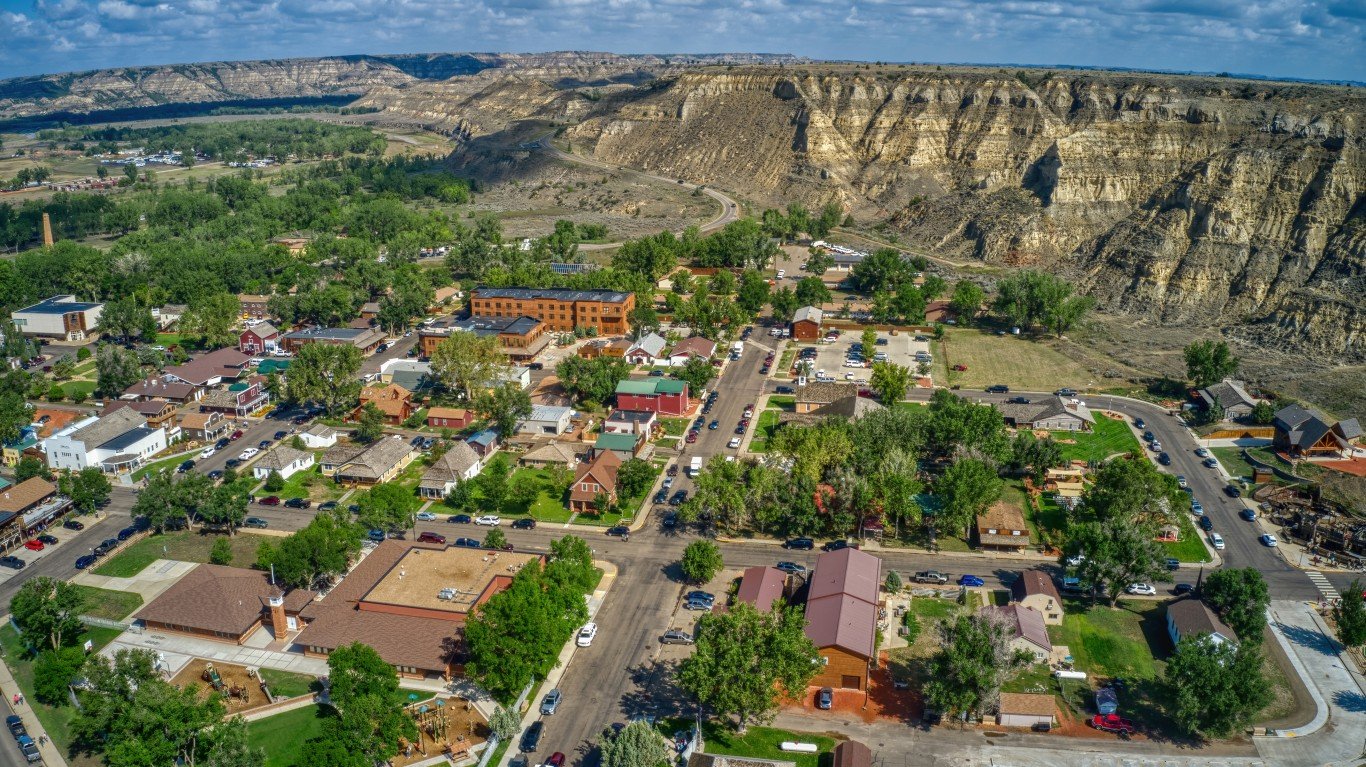

Most Americans are woefully underprepared for retirement. Based on analysis of Federal Reserve data by the accounting firm PwC, the typical American between the ages of 55 and 64 has just $120,000 in a retirement savings account. Though the vast majority of retirees supplement their savings with Social Security income, the average monthly Social Security payment is only $1,694 – not nearly enough to cover typical living expenses, let alone luxuries like travel and dining out.
Partially as a result, the number of Americans working past retirement age is rising fast. Data from the Bureau of Labor Statistics shows that more than 26% Americans between ages 65 to 74 were still working in 2020, and that share is projected to hit 32% by 2030. In 1995, about 17.5% of Americans that age were working, and the percentage was even lower before that.
For those who do not want to work past age 65 and still be financially secure, there is a certain amount of money they can expect to need. This amount should account for expenditures throughout retirement and can come from retirement savings or other sources of income.
Using data from the BLS, the Bureau of Economic Analysis, and the National Center for Health Statistics, 24/7 Wall St. determined estimated average expenditures throughout retirement in each state. We adjusted the BLS’s calculation of annual expenditures for 65 years and older residents in 2021 by the cost of living in each state and multiplied that figure by 18.5, the life expectancy at 65, to provide the amount of money the average retiree would spend throughout retirement. We also accounted for inflation and added 15% for a financial cushion.
Based on these calculations, the typical 65 year old American can expect to spend just over $1.3 million in retirement. This amount can vary, from $1.1 million to over $1.5 million, depending on the state they live in. While some of these expenses are covered by Social Security, many of them require other income sources, such as investment income, a pension plan, or savings. (Here is a look at the 8 best investments for retirees.)
Older Americans on tighter budgets can save hundreds of thousands of dollars by residing in states with a low cost of living. In many Southern states, as well as several states in the Midwest, goods and services cost well below the national average – in some cases over 10% lower. Conversely, in certain states along the West Coast and in the Northeast, living expenses can be anywhere from 6% to 13% higher than the national average. (Here is a look at where retirees are moving.)
Click here to see what it costs to retire comfortably in every state.
Click here to read our detailed methodology.

Alabama
> Estimated lifetime retirement spending: $1,169,013 (2nd lowest)
> Avg. cost of living: 11.9% lower than avg.
> Median income for 65 & older households, 2021: $53,913 (5th lowest)
> Pop. 65 and older: 17.6% (23rd highest)
[in-text-ad]

Alaska
> Estimated lifetime retirement spending: $1,385,205 (8th highest)
> Avg. cost of living: 4.4% higher than avg.
> Median income for 65 & older households, 2021: $77,845 (12th highest)
> Pop. 65 and older: 13.4% (3rd lowest)

Arizona
> Estimated lifetime retirement spending: $1,282,839 (22nd highest)
> Avg. cost of living: 3.3% lower than avg.
> Median income for 65 & older households, 2021: $69,056 (20th highest)
> Pop. 65 and older: 18.3% (13th highest)

Arkansas
> Estimated lifetime retirement spending: $1,186,335 (4th lowest)
> Avg. cost of living: 10.6% lower than avg.
> Median income for 65 & older households, 2021: $52,528 (4th lowest)
> Pop. 65 and older: 17.4% (25th lowest)
[in-text-ad-2]

California
> Estimated lifetime retirement spending: $1,482,796 (2nd highest)
> Avg. cost of living: 11.8% higher than avg.
> Median income for 65 & older households, 2021: $84,907 (5th highest)
> Pop. 65 and older: 15.2% (6th lowest)

Colorado
> Estimated lifetime retirement spending: $1,366,238 (10th highest)
> Avg. cost of living: 3.0% higher than avg.
> Median income for 65 & older households, 2021: $82,254 (9th highest)
> Pop. 65 and older: 15.1% (5th lowest)
[in-text-ad]

Connecticut
> Estimated lifetime retirement spending: $1,360,853 (11th highest)
> Avg. cost of living: 2.6% higher than avg.
> Median income for 65 & older households, 2021: $83,771 (8th highest)
> Pop. 65 and older: 18.0% (16th highest)

Delaware
> Estimated lifetime retirement spending: $1,295,518 (20th highest)
> Avg. cost of living: 2.3% lower than avg.
> Median income for 65 & older households, 2021: $71,091 (19th highest)
> Pop. 65 and older: 20.1% (5th highest)

Florida
> Estimated lifetime retirement spending: $1,345,295 (15th highest)
> Avg. cost of living: 1.4% higher than avg.
> Median income for 65 & older households, 2021: $63,062 (15th lowest)
> Pop. 65 and older: 21.1% (2nd highest)
[in-text-ad-2]

Georgia
> Estimated lifetime retirement spending: $1,270,411 (24th highest)
> Avg. cost of living: 4.2% lower than avg.
> Median income for 65 & older households, 2021: $66,559 (25th highest)
> Pop. 65 and older: 14.7% (4th lowest)

Hawaii
> Estimated lifetime retirement spending: $1,501,762 (the highest)
> Avg. cost of living: 13.2% higher than avg.
> Median income for 65 & older households, 2021: $84,857 (6th highest)
> Pop. 65 and older: 19.6% (7th highest)
[in-text-ad]

Idaho
> Estimated lifetime retirement spending: $1,217,252 (17th lowest)
> Avg. cost of living: 8.2% lower than avg.
> Median income for 65 & older households, 2021: $66,474 (24th lowest)
> Pop. 65 and older: 16.5% (14th lowest)

Illinois
> Estimated lifetime retirement spending: $1,345,057 (16th highest)
> Avg. cost of living: 1.4% higher than avg.
> Median income for 65 & older households, 2021: $72,205 (17th highest)
> Pop. 65 and older: 16.6% (17th lowest)

Indiana
> Estimated lifetime retirement spending: $1,229,971 (20th lowest)
> Avg. cost of living: 7.3% lower than avg.
> Median income for 65 & older households, 2021: $62,743 (14th lowest)
> Pop. 65 and older: 16.4% (12th lowest)
[in-text-ad-2]

Iowa
> Estimated lifetime retirement spending: $1,187,966 (5th lowest)
> Avg. cost of living: 10.4% lower than avg.
> Median income for 65 & older households, 2021: $65,600 (21st lowest)
> Pop. 65 and older: 17.8% (20th highest)

Kansas
> Estimated lifetime retirement spending: $1,209,042 (12th lowest)
> Avg. cost of living: 8.8% lower than avg.
> Median income for 65 & older households, 2021: $64,124 (18th lowest)
> Pop. 65 and older: 16.7% (18th lowest)
[in-text-ad]

Kentucky
> Estimated lifetime retirement spending: $1,182,077 (3rd lowest)
> Avg. cost of living: 10.9% lower than avg.
> Median income for 65 & older households, 2021: $55,573 (7th lowest)
> Pop. 65 and older: 17.0% (24th lowest)

Louisiana
> Estimated lifetime retirement spending: $1,210,620 (13th lowest)
> Avg. cost of living: 8.7% lower than avg.
> Median income for 65 & older households, 2021: $52,087 (3rd lowest)
> Pop. 65 and older: 16.6% (16th lowest)

Maine
> Estimated lifetime retirement spending: $1,289,258 (21st highest)
> Avg. cost of living: 2.8% lower than avg.
> Median income for 65 & older households, 2021: $64,767 (19th lowest)
> Pop. 65 and older: 21.7% (the highest)
[in-text-ad-2]

Maryland
> Estimated lifetime retirement spending: $1,408,866 (7th highest)
> Avg. cost of living: 6.2% higher than avg.
> Median income for 65 & older households, 2021: $90,203 (the highest)
> Pop. 65 and older: 16.3% (11th lowest)

Massachusetts
> Estimated lifetime retirement spending: $1,413,270 (6th highest)
> Avg. cost of living: 6.6% higher than avg.
> Median income for 65 & older households, 2021: $89,645 (2nd highest)
> Pop. 65 and older: 17.4% (25th highest)
[in-text-ad]

Michigan
> Estimated lifetime retirement spending: $1,250,105 (24th lowest)
> Avg. cost of living: 5.7% lower than avg.
> Median income for 65 & older households, 2021: $63,498 (17th lowest)
> Pop. 65 and older: 18.1% (15th highest)

Minnesota
> Estimated lifetime retirement spending: $1,305,413 (19th highest)
> Avg. cost of living: 1.6% lower than avg.
> Median income for 65 & older households, 2021: $77,720 (13th highest)
> Pop. 65 and older: 16.8% (19th lowest)

Mississippi
> Estimated lifetime retirement spending: $1,148,614 (the lowest)
> Avg. cost of living: 13.4% lower than avg.
> Median income for 65 & older households, 2021: $48,716 (the lowest)
> Pop. 65 and older: 16.8% (20th lowest)
[in-text-ad-2]

Missouri
> Estimated lifetime retirement spending: $1,220,514 (18th lowest)
> Avg. cost of living: 8.0% lower than avg.
> Median income for 65 & older households, 2021: $61,847 (11th lowest)
> Pop. 65 and older: 17.6% (22nd highest)

Montana
> Estimated lifetime retirement spending: $1,214,480 (15th lowest)
> Avg. cost of living: 8.4% lower than avg.
> Median income for 65 & older households, 2021: $63,249 (16th lowest)
> Pop. 65 and older: 19.7% (6th highest)
[in-text-ad]

Nebraska
> Estimated lifetime retirement spending: $1,216,920 (16th lowest)
> Avg. cost of living: 8.2% lower than avg.
> Median income for 65 & older households, 2021: $66,817 (24th highest)
> Pop. 65 and older: 16.4% (13th lowest)

Nevada
> Estimated lifetime retirement spending: $1,267,214 (25th highest)
> Avg. cost of living: 4.5% lower than avg.
> Median income for 65 & older households, 2021: $66,274 (23rd lowest)
> Pop. 65 and older: 16.5% (15th lowest)

New Hampshire
> Estimated lifetime retirement spending: $1,359,620 (12th highest)
> Avg. cost of living: 2.5% higher than avg.
> Median income for 65 & older households, 2021: $88,465 (4th highest)
> Pop. 65 and older: 19.3% (8th highest)
[in-text-ad-2]

New Jersey
> Estimated lifetime retirement spending: $1,447,011 (4th highest)
> Avg. cost of living: 9.1% higher than avg.
> Median income for 65 & older households, 2021: $89,296 (3rd highest)
> Pop. 65 and older: 16.9% (21st lowest)

New Mexico
> Estimated lifetime retirement spending: $1,192,462 (6th lowest)
> Avg. cost of living: 10.1% lower than avg.
> Median income for 65 & older households, 2021: $53,992 (6th lowest)
> Pop. 65 and older: 18.5% (12th highest)
[in-text-ad]

New York
> Estimated lifetime retirement spending: $1,452,383 (3rd highest)
> Avg. cost of living: 9.5% higher than avg.
> Median income for 65 & older households, 2021: $74,314 (14th highest)
> Pop. 65 and older: 17.5% (24th highest)

North Carolina
> Estimated lifetime retirement spending: $1,244,163 (23rd lowest)
> Avg. cost of living: 6.2% lower than avg.
> Median income for 65 & older households, 2021: $61,972 (12th lowest)
> Pop. 65 and older: 17.0% (23rd lowest)

North Dakota
> Estimated lifetime retirement spending: $1,208,325 (11th lowest)
> Avg. cost of living: 8.9% lower than avg.
> Median income for 65 & older households, 2021: $66,519 (25th lowest)
> Pop. 65 and older: 16.0% (7th lowest)
[in-text-ad-2]

Ohio
> Estimated lifetime retirement spending: $1,226,310 (19th lowest)
> Avg. cost of living: 7.5% lower than avg.
> Median income for 65 & older households, 2021: $62,262 (13th lowest)
> Pop. 65 and older: 17.8% (19th highest)

Oklahoma
> Estimated lifetime retirement spending: $1,197,264 (8th lowest)
> Avg. cost of living: 9.7% lower than avg.
> Median income for 65 & older households, 2021: $55,826 (8th lowest)
> Pop. 65 and older: 16.2% (9th lowest)
[in-text-ad]

Oregon
> Estimated lifetime retirement spending: $1,366,543 (9th highest)
> Avg. cost of living: 3.0% higher than avg.
> Median income for 65 & older households, 2021: $71,562 (18th highest)
> Pop. 65 and older: 18.6% (11th highest)

Pennsylvania
> Estimated lifetime retirement spending: $1,278,196 (23rd highest)
> Avg. cost of living: 3.6% lower than avg.
> Median income for 65 & older households, 2021: $68,957 (21st highest)
> Pop. 65 and older: 19.0% (9th highest)

Rhode Island
> Estimated lifetime retirement spending: $1,353,956 (14th highest)
> Avg. cost of living: 2.1% higher than avg.
> Median income for 65 & older households, 2021: $74,008 (15th highest)
> Pop. 65 and older: 18.3% (14th highest)
[in-text-ad-2]

South Carolina
> Estimated lifetime retirement spending: $1,242,677 (22nd lowest)
> Avg. cost of living: 6.3% lower than avg.
> Median income for 65 & older households, 2021: $59,318 (9th lowest)
> Pop. 65 and older: 18.6% (10th highest)

South Dakota
> Estimated lifetime retirement spending: $1,195,646 (7th lowest)
> Avg. cost of living: 9.9% lower than avg.
> Median income for 65 & older households, 2021: $66,143 (22nd lowest)
> Pop. 65 and older: 17.6% (21st highest)
[in-text-ad]

Tennessee
> Estimated lifetime retirement spending: $1,205,023 (10th lowest)
> Avg. cost of living: 9.1% lower than avg.
> Median income for 65 & older households, 2021: $59,695 (10th lowest)
> Pop. 65 and older: 17.0% (22nd lowest)

Texas
> Estimated lifetime retirement spending: $1,306,460 (18th highest)
> Avg. cost of living: 1.5% lower than avg.
> Median income for 65 & older households, 2021: $66,963 (23rd highest)
> Pop. 65 and older: 13.2% (2nd lowest)

Utah
> Estimated lifetime retirement spending: $1,254,601 (25th lowest)
> Avg. cost of living: 5.4% lower than avg.
> Median income for 65 & older households, 2021: $79,449 (11th highest)
> Pop. 65 and older: 11.6% (the lowest)
[in-text-ad-2]

Vermont
> Estimated lifetime retirement spending: $1,308,556 (17th highest)
> Avg. cost of living: 1.3% lower than avg.
> Median income for 65 & older households, 2021: $72,431 (16th highest)
> Pop. 65 and older: 20.6% (4th highest)

Virginia
> Estimated lifetime retirement spending: $1,356,543 (13th highest)
> Avg. cost of living: 2.3% higher than avg.
> Median income for 65 & older households, 2021: $80,963 (10th highest)
> Pop. 65 and older: 16.3% (10th lowest)
[in-text-ad]

Washington
> Estimated lifetime retirement spending: $1,444,173 (5th highest)
> Avg. cost of living: 8.9% higher than avg.
> Median income for 65 & older households, 2021: $84,247 (7th highest)
> Pop. 65 and older: 16.2% (8th lowest)

West Virginia
> Estimated lifetime retirement spending: $1,203,816 (9th lowest)
> Avg. cost of living: 9.2% lower than avg.
> Median income for 65 & older households, 2021: $51,248 (2nd lowest)
> Pop. 65 and older: 20.7% (3rd highest)

Wisconsin
> Estimated lifetime retirement spending: $1,238,088 (21st lowest)
> Avg. cost of living: 6.7% lower than avg.
> Median income for 65 & older households, 2021: $67,125 (22nd highest)
> Pop. 65 and older: 17.9% (18th highest)
[in-text-ad-2]

Wyoming
> Estimated lifetime retirement spending: $1,212,503 (14th lowest)
> Avg. cost of living: 8.6% lower than avg.
> Median income for 65 & older households, 2021: $65,204 (20th lowest)
> Pop. 65 and older: 17.9% (17th highest)
Methodology
To determine the estimated average expenditures throughout retirement in every state, 24/7 Wall St. calculated the amount of money the average retiree would spend through the rest of his or her life using data from the Bureau of Labor Statistics, Bureau of Economic Analysis, and the National Center for Health Statistics.
Our calculation was based on the average annual expenditure for U.S. residents 65 years and older in 2021 of $52,141, according to the BLS Consumer Expenditure Survey. We adjusted that figure by local cost of living, using state-level data on regional price parity in 2021. We then multiplied that figure by 18.5, the average life expectancy of a 65 year old American, according to the NCHS’s National Vital Statistics Reports.
For each year of life beyond age 65, we added 2% of annual expenditures to account for inflation, based on the Federal Reserve’s target inflation rate. For the final half year of life expectancy beyond age 65, we added 1% for inflation and divided annual expenditures in half.
Finally, we took the sum of each year’s cost of living and inflation-adjusted expenditures and multiplied it by 115% in order to reflect greater financial stability and comfort in retirement.
Supplementary data on median income for households age 65 and over and the share of population age 65 and over is from the U.S. Census Bureau’s 2021 American Community Survey.
Sponsored: Want to Retire Early? Here’s a Great First Step
Want retirement to come a few years earlier than you’d planned? Or are you ready to retire now, but want an extra set of eyes on your finances?
Now you can speak with up to 3 financial experts in your area for FREE. By simply clicking here you can begin to match with financial professionals who can help you build your plan to retire early. And the best part? The first conversation with them is free.
Click here to match with up to 3 financial pros who would be excited to help you make financial decisions.
Thank you for reading! Have some feedback for us?
Contact the 24/7 Wall St. editorial team.
 24/7 Wall St.
24/7 Wall St. 24/7 Wall St.
24/7 Wall St.


